|
On Planning for development: UNCTAD
World Investment Reports
|
Published by United Nations Conference on Trade and
Development - UNCTAD
World Investment Reports
(complete series since 1991):
|
|
World Investment Report 2017
- Investment and the Digital Economy - (UNCTAD/WIR/2017) - 07 Jun 2017, 110.0 KB
|
|
World
Investment Report 2016.
- Investor Nationality: Policy Challenges -
|
WORLD
INVESTMENT REPORT 2015....
Reforming International Investment Governance
Growing unease with the current functioning of the
global international investment agreement (IIA) regime,
together with today’s sustainable development
imperative, the greater role of governments in
the economy and the evolution of the investment
landscape, have triggered a move towards reforming
international investment rule making to make it better
suited for today’s policy challenges. As a result,the IIA
regime is going through a period of reflection, review
and revision. As evident from UNCTAD’s October 2014 World Investment Forum (WIF), from the heated public debate taking place in many countries, and from various parliamentary hearing processes, including at the regional level, a shared view is emerging on the need for reform of the IIA regime to ensure that it works for all stakeholders. The question is not about whether to reform or not, but about the what, how and extent of such reform.
|
World
Investment Report 2014 -
Investing in the SDGs: An Action Plan -
24 Jun 2014, 265 Pages, 10241.0 KB
|
WORLD
INVESTMENT REPORT 2013
Global Value Chains:
Investment and trade for development
About 60 per cent of global trade, which today amounts to more than
$20 trillion, consists of trade in intermediate goods and services that are
incorporated at various stages in the production process of goods and
services for final consumption. The fragmentation of production processes
and the international dispersion of tasks and activities within them have led to
the emergence of borderless production systems. These can be sequential
chains or complex networks, their scope can be global or regional, and they
are commonly referred to as global value chains (GVCs).
GVCs lead to a significant amount of double counting in trade, as intermediates
are counted several times in world exports but should be counted only once
as “value added in trade”. Today, some 28 per cent of gross exports consist
of value added that is first imported by countries only to be incorporated in
products or services that are then exported again. Some $5 trillion of the $19
trillion in global gross exports (in 2010 figures) is double counted.
Patterns of value added trade in GVCs determine the distribution of actual
economic gains from trade to individual economies.
|
WORLD
INVESTMENT REPORT 2012
Towards a New Generation of Investment Policies
Mobilizing investment and ensuring
that it contributes to sustainable development is a priority for all
countries. A new generation of investment policies is emerging, as
governments pursue a broader and more intricate development policy
agenda, while building or maintaining a generally favourable investment
climate.
“New generation” investment policies place inclusive growth and
sustainable development at the heart of efforts to attract and benefit
from investment. This leads to specific investment policy challenges at
the national and international levels. At the national level, these
include integrating investment policy into development strategy,
incorporating sustainable development objectives in investment policy
and ensuring investment policy relevance and effectiveness. At the
international level, there is a need to strengthen the development
dimension of international investment agreements (IIAs), balance the
rights and obligations of States and investors, and manage the systemic
complexity of the IIA regime.
To address these challenges, UNCTAD has formulated a comprehensive
Investment Policy Framework for Sustainable Development (IPFSD),
consisting of
(i) Core Principles for investment policymaking,
(ii) guidelines for national investment policies, and
(iii) options for the design and use of IIAs.
UNCTAD’s IPFSD can serve as a point of reference for policymakers in
formulating national investment policies and in negotiating or
reviewing IIAs. It provides a common language for discussion and
cooperation on national and international investment policies. It has
been designed as a “living document” and incorporates an online version
that aims to establish an interactive, open-source platform, inviting
the investment community to exchange views, suggestions and experiences
related to the IPFSD for the inclusive and participative development of
future investment policies.
|
WORLD
INVESTMENT REPORT 2011
Non-equity modes of international production and development
Cross-border non-equity modes (NEMs)
of international production generated at least $2 trillion in sales
globally in 2010 and are growing rapidly, shaping world trade and
investment patterns, with important implications for development...
...international production is not exclusively about foreign direct
investment (FDI) on the one hand and trade on the other. NEMs - which
include contract manufacturing, services outsourcing, contract farming,
franchising, licensing, and management contracts - allow transnational
corporations to coordinate activities in their global value chains and
influence the management of host-country firms without owning equity
stakes in those firms. Transnational corporations manage the activities
of NEM partner firms in their global value chains - for example, a
local company in a host country assembling a product or providing
information technology (IT) support - through contracts or, equally
important, through access to transnational corporations´ technology,
skills, business models or internal markets. Transnational corporations
seldom take equity stakes in NEM partner firms, although the partner
firms are tied to the transnational corporations´ global networks.
...UNCTAD...cites concerns about the impact of NEMs in host developing
economies. For example, working conditions may be poor, particularly in
the case of contract manufacturing in labour-intensive activities,
since NEM partner firms are under strong competitive pressure to reduce
costs. In some instances, NEMs can be used to circumvent social and
environmental standards. The report also points to pitfalls for
long-term industrial development: Developing countries need to mitigate
the risk of remaining locked into low value-added activities and need
to avoid overdependence on foreign technologies and inputs.
|
WORLD INVESTMENT REPORT 2010
Investing in a low-carbon economy
There are some major changes in global
FDI patterns that preceded the global crisis
and that will most likely gain momentum
in the short and medium term. Firstly, the
relative weight of developing and transition
economies as both destinations and sources
of global FDI is expected to keep increasing.
These economies, which absorbed almost
half of FDI inflows in 2009, are leading the
FDI recovery. Secondly, the recent further
decline in manufacturing FDI, relative to
that in the services and primary sectors, is
unlikely to be reversed. Thirdly, in spite
of its serious impact on FDI, the crisis has
not halted the growing internationalization
of production.
This year’s Report focuses on climate change, and in particular the
role of transnational
corporations. As enterprises with formidable knowledge, cutting-edge
technology, and
global reach, TNCs are necessarily among the primary actors in the
global effort to reduce
greenhouse gas emissions and shift towards a low-carbon economy. The
Report stresses
that with the right policy initiatives, incentives and regulatory
framework, TNCs can and
must contribute significantly to both mitigation and adaptation. It
also proposes a global
partnership to galvanize low-carbon investment and advocates concrete
initiatives such
as a new technical assistance centre to support policy formulation and
implementation in
developing countries.
|
WORLD
INVESTMENT REPORT 2009
Transnational Corporations, Agricultural Production and Development
The Report covers, in particular, questions such as:
- What are the differences between individual
regions in terms of their responses in FDI flows to the crisis? Why did
the crisis affect FDI to developing countries later than developed
countries?
- What are the prospects for FDI in 2009 as well as
for the medium term?
- How has the crisis affected national and
international policies related to FDI? Has the path of more
liberalizations been continued or reversed?
- In the midst of a major industrial restructuring,
which companies are the winners and losers in the universe of the
world´s largest TNCs?
- Why is agriculture such a special industry for
developing countries - and what are its longer term prospects? What
role can TNCs play in improving the productivity of agriculture in
developing economies?
- How robust is the renewed interest by TNCs in
agriculture? Who are the new investors and how do they differ from
traditional TNCs? What are the pros and cons of developing country
farmers being drawn into global agribusiness value chains?
- What can developing countries expect from the
renewal of FDI in agriculture? Given the past record, will this time
the impact of TNCs in agriculture be different?
- How does TNC participation in agricuture affect
socially sensitive issues, including those related to food security and
the food crisis; as well as the non-food uses of agricultural produce
for biofuels?
- What policy challenges does TNC involvement in
agriculture raise? How are they being addressed within the framework
national economic strategies, with the aim of maximizing benefits and
minimizing costs from TNC involvement?
- Are policy makers sufficiently prepared to meet
the challenges? How can the international community support them?
According to WIR09, after decades of slow growth, TNCs´
interest and participation in agriculture - including FDI - is again on
the rise. Despite this rise, in most countries today only a small share
of FDI goes to agriculture. There are nevertheless some developing
countries, including least developed countries (LDCs), where the share
of agriculture in inward FDI is relatively important. Renewed interest
of foreign investors in agricultural investment is significant enough
to raise questions about whether FDI and other forms of TNC
participation in agriculture can contribute to the development of this
long neglected industry. WIR09 suggests an integrated policy approach
that takes into account all concerns arising from TNC involvement.
|
WORLD
INVESTMENT REPORT 2008
Transnational corporations and the infrastructure challenge
Host countries need to consider when it is
appropriate to draw TNCs into the development and
management of infrastructure. They also need to find
ways of ensuring that projects with TNC involvement
lead to the expected development effects. This is a
complex policy challenge.
As policy priorities and options vary between
countries, so too does the optimal mix of public
and private (including TNC) investment. Designing
and implementing appropriate policies to harness
the potential role of TNCs in infrastructure require
adequate skills and capabilities. Governments need
to prioritize among competing demands for different
projects, establish clear and realistic objectives for
the projects chosen, and integrate them into broader
development strategies. This means that government
agencies have to possess the necessary institutional
capacity and skills to guide, negotiate, regulate and
monitor the projects. This applies not only at the
central level, but also in provincial and municipal
governments.
While many developing countries seek foreign
investment to develop their physical infrastructure,
convincing foreign companies to invest has in many
cases become even more challenging.
|
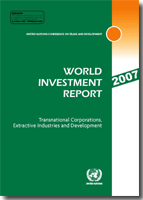
WORLD INVESTMENT REPORT 2007
Transnational
Corporations, Extractive Industries and development
World
Investment Report 2007 (WIR07) is the seventeenth in a
series published by the United Nations Conference on Trade and
Development (UNCTAD). The Report analyses the latest
trends in foreign direct investment (FDI) and puts a special focus in
2007 on the role of transnational corporations (TNCs) in the extraction
of oil, gas, and metal minerals.
Higher
prices for many minerals have led to renewed investor interest in the
extractive industries. TNCs ( including some of the world´s
largest corporations) play a key role in the mining of metals and in
the extraction of oil and gas. Privately owned TNCs dominate the
harvesting of metal minerals, while State-owned companies from
developing and transition economies are key players in oil and gas.
Many such State-owned firms are emerging as TNCs in their own right.
Drawing
on unique data, the Report examines TNC involvement
in the extraction of mineral resources and maps the key countries and
companies. It also discusses how the forces driving investment change
as raw materials progress up the "value chain" to become finished
products, and as different types of companies participate. In view of
recent discussion of the so-called "resource curse," the Report
explores how the participation of TNCs may help or
hinder long-term, broad-based economic development in developing
countries -- the best approach for reducing poverty and raising living
standards. It considers how energy and mineral extraction can help
governments achieve such aims.
In
addition to the general information on definitions and sources provided
in this year´s World Investment Report, more detailed
methodological notes for the data on FDI flows and stocks used in the
Report - including how they were obtained for each economy - are
available in electronic format only.
|
 WORLD INVESTMENT REPORT 2006 WORLD INVESTMENT REPORT 2006
FDI from Developing and Transition Economies: Implications for
Development
This year´s World Investment Report focuses on the
rise of foreign direct investment (FDI) by transnational corporations
(TNCs) from developing and transition economies.
New sources of FDI are emerging among developing and transition
economies. This phenomenon has been particularly marked in the past ten
years, and a growing number of TNCs from these economies are emerging
as major regional - or sometimes even global - players. The new links
these TNCs are forging with the rest of the world will have
far-reaching repercussions in shaping the global economic landscape of
the coming decades.
The Report examines the magnitude of this phenomenon and examines its
drivers and determinants, i.e.: what economic factors and policy
developments lead firms from developing countries to venture abroad?
For low-income countries, FDI from developing countries can be of great
importance. In some of them, it accounts for a significant share of all
FDI flows. The Report also discusses the development implications of
the rise of these new sources of FDI, along with policy responses, for
both home and host developing countries.
As in previous years, the Report also presents the latest data on FDI
and traces the global and regional trends of FDI and international
production by TNCs. Global FDI inflows rose substantially in 2005. A
major contributing factor to this strong growth was the marked increase
in the inflows to developed countries. Rising global demand for
commodities was reflected in the steep increase in natural
resource-related FDI, although the services sector continued to be the
major recipient of FDI. Among developing regions, Asia remained the
main magnet for FDI flows, followed by Latin America, where re-invested
earnings have played a major role. Africa´s share in world FDI inflows
was still small, but its FDI growth rate has nonetheless surpassed
those of other developing regions.
A substantial Statistical Annex is also included,
with data on FDI flows and stock for more than 200 economies. The PDF
version of WIR05 and the Statistical Annex are available in a CD-ROM.
METHODOLOGICAL NOTES: Definitions and Sources. In addition to the
general information on definitions and sources provided in this year´s World
Investment Report, more detailed methodological notes for the data
on FDI flows and stocks used in the Report - including how they were
obtained for each economy - are available in electronic format only.
|
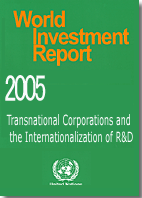 WORLD INVESTMENT REPORT 2005 WORLD INVESTMENT REPORT 2005
Transnational Corporations and the Internationalization of R&D
World
Investment Report 2005 (WIR05) presents the latest trends in
foreign direct investment (FDI) and explores the internationalization
of research and development by transnational corporations (TNCs) along
with the development implications of this phenomenon.
Part One highlights recent global and
regional trends in FDI and international production by TNCs. Global FDI
flows resumed growth in 2004, but inflows continued to decline in
developed countries. This Part documents the fact that developing
regions are leading the recovery in FDI flows. It also documents
different trends and patterns between developed and developing
countries as regards the financing component of FDI (equity investment,
reinvested earnings, intra-company loans) as well as the modes of
investment (mergers and acquisitions, greenfield FDI).
Part Two assesses the implications of the
recent surge in R&D internationalization by TNCs. R&D
activities at growing levels of complexity are increasingly being
established in selected developing countries. In contrast to past
experience, this R&D often goes beyond local market adaptation and
involves highly complex activities targeted on global markets. The
Report discusses the driving forces behind this trend and considers how
host as well as home countries are affected. Finally, the Report
analyses the need for active government policies to enhance development
benefits from TNCs´ internationalization of R&D. The Report
underlines the importance of coherent policies in order to create an
environment conducive to fruitful interaction between the R&D
activities of TNCs and those of domestic firms and institutions. A
final chapter outlines the role of international agreements in this
area.
A substantial Statistical Annex is also included,
with data on FDI flows and stock for more than 200 economies. The PDF
version of WIR05 and the Statistical Annex are available in a CD-ROM.
METHODOLOGICAL NOTES: Definitions and Sources
In addition to the general information on definitions and sources
provided in this year´s World Investment Report, more
detailed methodological notes for the data on FDI flows and stocks used
in the Report - including how they were obtained for each economy - are
available in electronic format only.
|
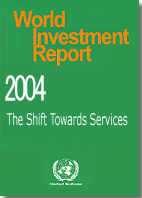 WORLD INVESTMENT REPORT 2004 WORLD INVESTMENT REPORT 2004
The Shift Towards Services
WIR04 presents the latest trends in foreign direct
investment and explores the shift towards services, with a special
analysis of offshoring service activities.
Part One discusses recent global and regional
trends in FDI and international production by TNCs. Global FDI flows
bottomed out in 2003, but there were some regional differences. The
sectoral pattern of FDI is shifting towards services. Outward FDI from
developing countries is becoming significant. There is also optimism
that inflows to these countries will increase in 2004 and beyond.
Part Two deals with FDI in services - an important
but often neglected area of FDI in the context of development. It
examines the shift of FDI towards services with a focus on the entry of
TNCs into new service areas. Services FDI, especially in intermediate
and infrastructure services, affects the economic performance of a
host-country in all sectors. The offshoring of corporate services is
taking off rapidly, thanks to advances in information and
communications technologies. However, the potential of such offshoring
can only be harnessed if countries adopt appropriate policies.
Part Three analyses key issues relating to
national and international policies on FDI in services. As many
services are deeply embedded in the social, cultural and political
fabric of host societies, the impact of FDI on those services could be
far-reaching. Therefore, national policies matter - not only to attract
FDI in services, but also to maximize its benefits and minimize its
potential negative impacts. The proliferation of international
investment agreements (IIAs) covering FDI in services has resulted in a
multifaceted and multilayered network of international rules that
affect national policy-making.
The WIR04 includes a substantial statistical annex, which is
also available on CD-ROM.
Quick Links: | World
Investment Directory Online |
|
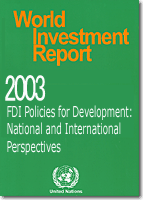
WORLD INVESTMENT REPORT 2003
FDI Policies for Development: National and International Perspectives
The World Investment Report 2003 focuses on the foreign direct
investment (FDI) downturn, its reasons and the role of national
policies and international investment agreements (IIA) in attracting
FDI to a country and for a country to benefit from it.
Part One discusses the overall trends in FDI. FDI flows have dropped
drastically and no rebound is expected in 2003. The reasons for the
downturn are discussed from a global perspective, as well as by region
- developed countries, Africa, Asia and the Pacific, Latin America and
the Caribbean, and Central and Eastern Europe.
Part Two focuses on key issues that straddle national FDI policies and
international investment agreements with a view to bringing out the
development dimension. Special attention is given to the rise of IIAs,
the right to regulate, home country measures and corporate social
responsibility.
The report includes a statistical annex of over 100 pages.
Quick Links: | Press
Conference Opening Statements |
|
 WORLD INVESTMENT REPORT 2002 WORLD INVESTMENT REPORT 2002
Transnational Corporations and Export Competitiveness
The first principal finding is that foreign direct investment (FDI)
inflows in 2001 declined to $735 billion. This is less than half the
2000 figure. Behind this decline is the slowdown in the world economy
and a weakening of business confidence, both of which were accentuated
by the September 11 events in the United States, and both of which
contributed to a sharp reduction of cross border mergers and
acquisitions that take place predominantly between industrialized
countries. In light of the prolonged economic recession and the slow
recovery of business confidence, especially in the United States,
UNCTAD does not expect a rebound of FDI flows this year. Despite the
decline in FDI flows, the expansion of international production
continues, although at a slower pace. However, developments differ
markedly between various parts of the world. The FDI downturn was
concentrated in the developed countries (-59%), with only modest
declines in flows to developing countries (-14%) and even a small
increase in flows to Central and Eastern Europe (2%). There were also
significant variations within the third world, with lower levels of
inflows to Asia and Latin America but an increase to Africa. Africa,
however, still remains a marginal recipient of FDI.
|

WORLD INVESTMENT REPORT 2001
Promoting linkages
The World Investment Report 2001 examines the issue of linkages between
foreign affiliates of multinational enterprises and local companies in
developing countries. Worldwide FDI flows again reached record levels
in 2000. FDI remains the main driver of the expansion of the
international production system. Forging linkages between foreign
affiliates and domestic firms is a main challenge for policy-makers in
developing countries in order to benefit from FDI as much as possible.
WIR 2001 pays particular attention to this challenge. The objective is
not to raise linkages at any cost, but to use them to upgrade the
competitive capabilities of domestic enterprises. Fostering linkages is
an important means of diffusing knowledge, information and skills from
a foreign investor. In a technology and skill driven world, this can
contribute to increasing the efficiency and growth potential of the
host economy. WIR 2001 provides valuable information on country and
company experience in this field.
|
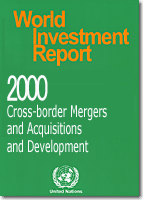
WORLD INVESTMENT REPORT 2000
Cross-border Mergers and Acquisitions and Development
The contribution of foreign direct investment to development is now
widely recognized.
There is a perception, however, that this contribution may be affected
by the way investment enters a country. It may come in the form of a
new enterprise or the expansion of an existing enterprise; it may also
come through a merger or an acquisition. Acquisitions, in particular,
arouse concerns, especially over employment, ownership and market
structure. And the concerns become urgent when the host economy is a
developing one.
Given the recent explosion in cross-border mergers and acquisitions,
UNCTAD´s 10th World Investment Report is a highly timely and important
document. This phenomenon calls for just the sort of careful and
dispassionate analysis that has become the hallmark of the WIRs.
Cross-border mergers and acquisitions are a part of economic life in a
liberalizing and globalizing world. But accepting a more open market in
the interests of growth and development does not mean relaxing the
requirements of public vigilance. On the contrary, a freer market - and
particularly the emerging global market for enterprises - calls for
greater vigilance as well as stronger and better governance. To this
end, World Investment Report 2000 provides us with a valuable resource.
Kofi A. Annan
Secretary-General of the United Nations
|
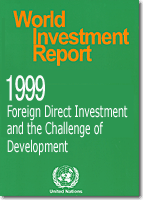 WORLD INVESTMENT REPORT 1999 WORLD INVESTMENT REPORT 1999
Foreign Direct Investment and the Challenge of Development
WIR 99 is the ninth Report in an annual series that has been recognized
as the most up-to-date and comprehensive source of information as well
as analysis regarding foreign direct investment (FDI).
Part I, entitled Trends,examines the most recent global and regional
trends in FDI. It describes the world´s 100 largest TNCs, the 50
largest TNCs in developing countries and the 25 largest TNCs in Central
Europe; analyses the momentum for an increasing globalization of
economies through FDI and the activities of TNCs; and explores the
growing importance of mergers and acquisitions in fuelling FDI flows.
It also reviews recent developments in bilateral and regional
investment agreements including the reasons for the end of negotiations
of the Multilateral Agreement on Investment.
Part II, entitled FDI and the Challenge of Development, looks at the
impact of FDI on key objectives of economic development: increasing
financial resources for investment, enhancing technological
capabilities, boosting export competitiveness, generating and upgrading
employment, and protecting the environment.
The Report concludes that although FDI can yield major economic
benefits for the host country, such benefits can be enhanced through
appropriate policies. Governments therefore have an important role to
play in creating the conditions that attract FDI and in maximizing the
positive contribution that FDI can make to growth and development.
|
1998 - Trends and Determinants
|
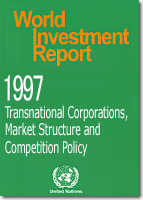
WORLD INVESTMENT REPORT 1997
Transnational corporations, market structure and competition policy
Improving economic
efficiency by making markets more competitive -- and thereby
serving development -- is subject to the same need to make choices.
Given the particular
characteristics of developing countries -- low income levels, skewed
distribution of wealth,
lack of infrastructure, low levels of education, asymmetries in
information, to mention a few -
- the incidence of conflicts between market outcomes and competing
objectives is often more
frequent in these countries.
For example, where foreign exchange is temporarily in limited supply,
certain import
restrictions might be needed -- thus limiting contestability -- to
ensure that critical imports are
not disrupted, e.g.,
that foreign exchange reserves are used for machine parts instead of
luxury goods. Or, where a
country is characterized by dispersed rural communities, the market
will often not provide
these with certain basic services (such as roads, telecommunications
services and railways); in
these cases, governments might need to ensure that certain services
reach segments of the
national market which otherwise could not support such services. They
could do so, for instance,
by providing the services through state-owned enterprises or, where
private operators are
involved, by providing these with market power so that services in
less-economically viable
markets can be cross-subsidized from profits earned in larger segments
of the market.48 A
policy alternative to consider in such a case would be more direct
government involvement in
the form of subsidized provision of the services in question. The
decision in this case -- whether
to allow concentration combined with cross subsidization or to provide
subsidies -- would
involve a careful consideration of the quite different trade-offs
associated with these two options
(possibly less efficiency in the market, on the one hand, versus a
direct budgetary expense on
the other).
|
1996 - Investment, Trade and International Policy
Agreements
1995 - TNCs and Competitiveness
|
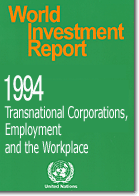
WORLD INVESTMENT REPORT 1994
Transnational corporations, employment and the workplace
The World Investment Report
1994 analyses the impact of an integrated international production
system on the quantity and quality of employment, human resource
development and, more generally, to the organization of work.
The report includes a statistical annex with FDI statistics and other
related indicators.
Policy makers and trade union leaders must find
innovative ways to
respond to the ongoing changes in the international economy. Not only
must they address the many new issues raised by integration at the
level of production; but, in a more open and integrated world economy,
policy makers must coordinate more carefully the traditional
instruments for domestic economic management with policies relating to
international economic relations, including, in particular, foreign
direct investment (FDI) and other forms of TNC
activity.
|
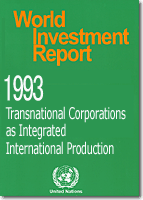 WORLD INVESTMENT REPORT 1993 WORLD INVESTMENT REPORT 1993
Transnational Corporations and Integrated International Production
The World Investment Report 1993 analyses the evolving strategies
and changing organizational structures of TNCs, and the implications of
the increasing functional, cross-national integration of their
activities for the location of international production. In spite
of an overall decline in world-wide flows of foreign direct investment
in the early 1990s, there are many features of the world economic
environment pointing to a continuing and important role for
transnational corporations.
The report includes a statistical annex with FDI statistics and other
related indicators.
|
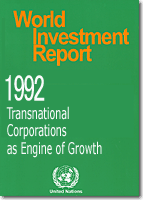 WORLD INVESTMENT REPORT 1992 WORLD INVESTMENT REPORT 1992
Transnational Corporations as Engines of Growth
The World
Investment Report 1992 analyses the relationship between TNCs and
economic growth. Since the early 1980s, world investment flows have
been expanding rapidly, much faster than other key economic variables
such as world trade and world output. A number of major new developments in the
global economic situation have placed foreign direct investment in a
central position to influence the pace and the nature of economic
growth in most countries. Finally, developing countries themselves have implemented
notable and, in many cases, dramatic policy changes, in order to open
their economies to greater contributions by transnational corporations.
The report includes a statistical annex with FDI statistics and other
related indicators.
|
 WORLD INVESTMENT REPORT 1991 WORLD INVESTMENT REPORT 1991
The Triad In Foreign Direct Investment
This first volume in the World Investment Report series analyses the
Triad (Japan, the European Community and the United States) in terms of
foreign direct investment.
It looks at the role transnational corporations play in
promoting regional economic integration around the three poles of the
Triad,
describes the linkages between foreign direct investment and
trade, technology and financial flows, and
highlights policy implications for developing countries and the
international community.
|
|
|